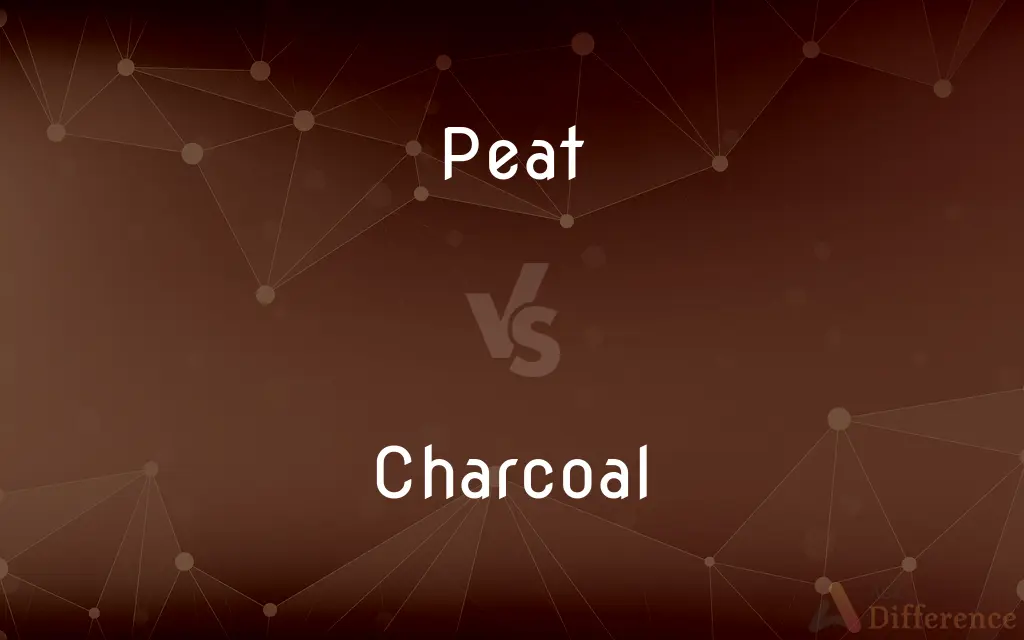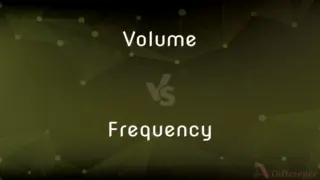Peat vs. Charcoal — What's the Difference?
Edited by Tayyaba Rehman — By Urooj Arif — Updated on April 23, 2024
Peat is partially decomposed organic matter from wetlands, used as fuel and in gardening, with a slow burn and low carbon content. Charcoal is carbon-rich, made by heating wood in the absence of oxygen, burning hotter and cleaner than peat.

Difference Between Peat and Charcoal
Table of Contents
ADVERTISEMENT
Key Differences
Peat forms in wetland environments over thousands of years as plant material partially decomposes under waterlogged conditions, creating a dense, fibrous substance. It is valued for its ability to slowly release heat when burned and for improving soil in gardening. Charcoal, on the other hand, is produced through the pyrolysis of wood, heating it in an environment with little to no oxygen. This process leaves behind a substance high in carbon content, making charcoal a preferred fuel for cooking and industrial processes due to its high heat output and relatively clean burn.
While peat is harvested from peat bogs, a process that can be ecologically disruptive, charcoal production can come from renewable sources, such as sustainably managed forests, and is considered a more environmentally friendly option when sourced responsibly. Peat's use in agriculture, particularly in potting mixes and as a soil conditioner, leverages its water retention and aeration properties, benefits that charcoal does not offer. Conversely, charcoal enriches soil by adding carbon and improving its fertility, but without the same water retention capabilities as peat.
The energy density of peat is significantly lower than that of charcoal, making peat a less efficient fuel in terms of the heat it can produce per unit. Charcoal’s higher energy density and cleaner burn make it suitable for a wide range of uses, including metal smelting and grilling, where high temperatures are required. Peat, with its lower burn temperature and higher moisture content, is more commonly used for heating in residential settings in regions where it is abundant.
In environmental terms, the use of peat as a fuel is controversial due to its role as a carbon sink; extracting peat releases stored carbon dioxide, contributing to greenhouse gas emissions. Charcoal's production also has environmental impacts, but modern methods aim to reduce emissions and, when made from renewable resources, can be part of a more sustainable cycle.
Peat's historical and cultural significance in regions like Ireland and Scotland, where it has been used for heating and whisky production for centuries, contrasts with charcoal's global use throughout history for cooking, metalworking, and art, highlighting the varied roles these substances play in human activities.
ADVERTISEMENT
Comparison Chart
Composition
Partially decomposed organic matter
Carbonized wood
Production Environment
Wetlands
Low-oxygen environment
Main Uses
Fuel, soil improvement in gardening
Cooking fuel, industrial processes
Environmental Impact
High, releases carbon dioxide
Lower when sourced sustainably
Energy Density
Lower
Higher
Moisture Content
High
Low
Heat Output
Slow, sustained burn
Hot, clean burn
Cultural Significance
Historical use in certain regions (e.g., Ireland)
Global use in cooking, art, industry
Compare with Definitions
Peat
Improves soil by adding organic matter.
Adding peat to the garden beds helped retain moisture and improve plant growth.
Charcoal
Made by heating wood without oxygen, leaving almost pure carbon.
We used charcoal for the barbecue to get a high, consistent heat.
Peat
A type of organic matter formed in wetlands, used as fuel and soil conditioner.
They used peat blocks for heating their home in the winter.
Charcoal
Can improve soil fertility by adding carbon.
Mixing charcoal into the soil can increase its fertility and support plant growth.
Peat
Harvested from peat bogs, impacting wetland ecosystems.
The extraction of peat for gardening has raised environmental concerns.
Charcoal
Environmentally preferable when sourced from sustainable wood.
Sustainable charcoal production from managed forests reduces environmental impact.
Peat
Holds historical significance in regions like Ireland.
Peat has been a traditional fuel in Irish homes for centuries.
Charcoal
Used in industrial processes requiring high temperatures.
Charcoal has been historically used in smelting to achieve the necessary heat.
Peat
Known for its slow-burning properties.
Peat fires, once started, can burn for a long time, providing sustained warmth.
Charcoal
Burns hotter and cleaner than wood or peat.
Charcoal is preferred for grilling due to its ability to reach higher temperatures without smoke.
Peat
Peat (), sometimes known as turf (), is an accumulation of partially decayed vegetation or organic matter. It is unique to natural areas called peatlands, bogs, mires, moors, or muskegs.
Charcoal
Charcoal is a lightweight black carbon residue produced by strongly heating wood (or other animal and plant materials) in minimal oxygen to remove all water and volatile constituents. In the traditional version of this pyrolysis process, called charcoal burning, the heat is supplied by burning part of the starting material itself, with a limited supply of oxygen.
Peat
A brown deposit resembling soil, formed by the partial decomposition of vegetable matter in the wet acidic conditions of bogs and fens, and often cut out and dried for use as fuel and in gardening
A peat bog
Mulch plants with leaf mould or peat
Charcoal
A porous black solid, consisting of an amorphous form of carbon, obtained as a residue when wood, bone, or other organic matter is heated in the absence of air.
Peat
Partly decomposed vegetable matter, usually mosses, found in bogs and sometimes burned as fuel or mixed into soil to improve growing conditions.
Charcoal
A black, porous, carbonaceous material, 85 to 98 percent carbon, produced by the destructive distillation of wood and used as a fuel, filter, and adsorbent.
Peat
Soil formed of dead but not fully decayed plants found in bog areas, often burned as fuel.
Charcoal
A drawing pencil or crayon made from this material.
Peat
(obsolete) A pet, a darling; a woman.
Charcoal
A drawing executed with such a pencil or crayon.
Peat
A small person; a pet; - sometimes used contemptuously.
Charcoal
A dark grayish brown to black or dark purplish gray.
Peat
A substance of vegetable origin, consisting of roots and fibers, moss, etc., in various stages of decomposition, and found, as a kind of turf or bog, usually in low situations, where it is always more or less saturated with water. It is often dried and used for fuel.
Charcoal
To draw, write, or blacken with a black, carbonaceous material.
Peat
Partially carbonized vegetable matter saturated with water; can be used as a fuel when dried
Charcoal
To charbroil.
Charcoal
Impure carbon obtained by destructive distillation of wood or other organic matter, that is, heating it in the absence of oxygen. Category:en:Carbon
Charcoal
(countable) A stick of black carbon material used for drawing.
Charcoal
(countable) A drawing made with charcoal.
Charcoal
A very dark gray colour.
Charcoal
Of a dark gray colour.
Charcoal
Made of charcoal.
Charcoal
To draw with charcoal.
Charcoal
To cook over charcoal.
Charcoal
Impure carbon prepared from vegetable or animal substances; esp., coal made by charring wood in a kiln, retort, etc., from which air is excluded. It is used for fuel and in various mechanical, artistic, and chemical processes.
Charcoal
Finely prepared charcoal in small sticks, used as a drawing implement.
Charcoal
A carbonaceous material obtained by heating wood or other organic matter in the absence of air
Charcoal
A stick of black carbon material used for drawing
Charcoal
A very dark gray color
Charcoal
A drawing made with charcoal
Charcoal
Draw, trace, or represent with charcoal
Charcoal
Very dark gray
Common Curiosities
Can the extraction of peat be environmentally sustainable?
Peat extraction is generally considered environmentally damaging because it disrupts wetland ecosystems and releases stored carbon dioxide, impacting climate change.
Is charcoal environmentally friendly?
When sourced from sustainably managed forests and produced using modern, efficient methods, charcoal can be part of a more sustainable cycle, though its production still impacts the environment.
Why is charcoal preferred for cooking over peat?
Charcoal burns hotter and cleaner than peat, making it suitable for cooking, especially grilling, where consistent, high heat is required.
How do peat and charcoal differ in their impact on soil?
Peat improves soil by adding organic matter and enhancing moisture retention, while charcoal can increase soil fertility by adding carbon but does not retain water as peat does.
What is peat primarily used for?
Peat is used as a fuel for heating and in gardening for soil improvement, thanks to its organic matter content and water retention properties.
Can peat and charcoal be used interchangeably?
Due to their different properties, peat and charcoal are not generally interchangeable; peat is better suited for soil amendment and low-heat applications, while charcoal is preferred for high-temperature uses.
What makes charcoal burn hotter than peat?
Charcoal's high carbon content and low moisture allow it to burn at higher temperatures compared to peat, which has a higher moisture content and lower energy density.
What are the environmental concerns with using peat and charcoal?
Peat extraction releases significant amounts of carbon dioxide, contributing to greenhouse gas emissions, while charcoal production impacts depend on the source of the wood and the production process.
How are peat and charcoal produced?
Peat forms naturally in wetlands over millennia as plant material partially decomposes, while charcoal is produced by heating wood in a controlled environment with limited oxygen.
What historical uses do peat and charcoal have?
Peat has a long history of use for heating and in whisky production in regions like Ireland and Scotland. Charcoal has been used globally for cooking, metal smelting, and even as a drawing material in art.
Share Your Discovery

Previous Comparison
Volume vs. Frequency
Next Comparison
Orthostatic vs. OrthostasisAuthor Spotlight
Written by
Urooj ArifUrooj is a skilled content writer at Ask Difference, known for her exceptional ability to simplify complex topics into engaging and informative content. With a passion for research and a flair for clear, concise writing, she consistently delivers articles that resonate with our diverse audience.
Edited by
Tayyaba RehmanTayyaba Rehman is a distinguished writer, currently serving as a primary contributor to askdifference.com. As a researcher in semantics and etymology, Tayyaba's passion for the complexity of languages and their distinctions has found a perfect home on the platform. Tayyaba delves into the intricacies of language, distinguishing between commonly confused words and phrases, thereby providing clarity for readers worldwide.











































